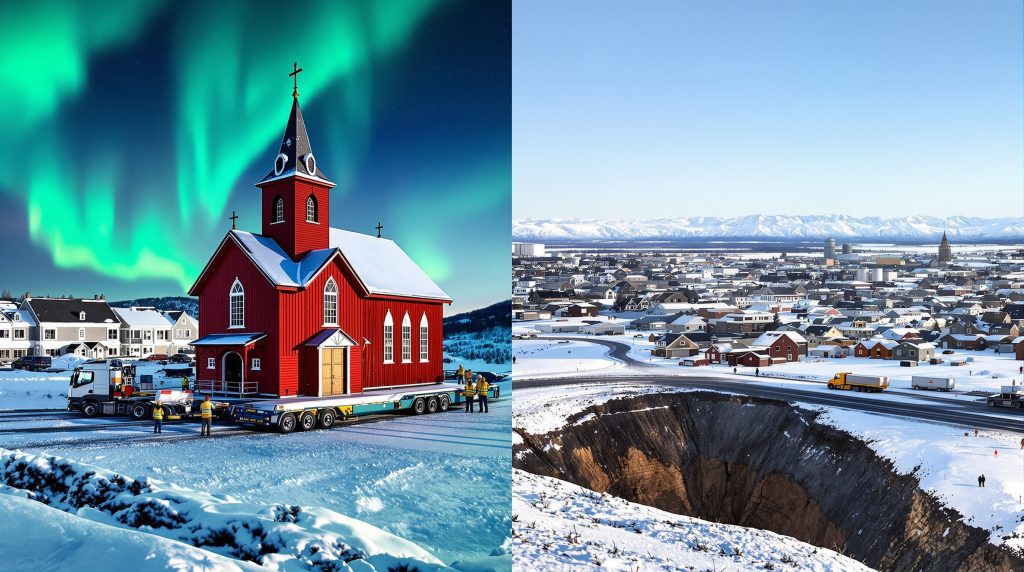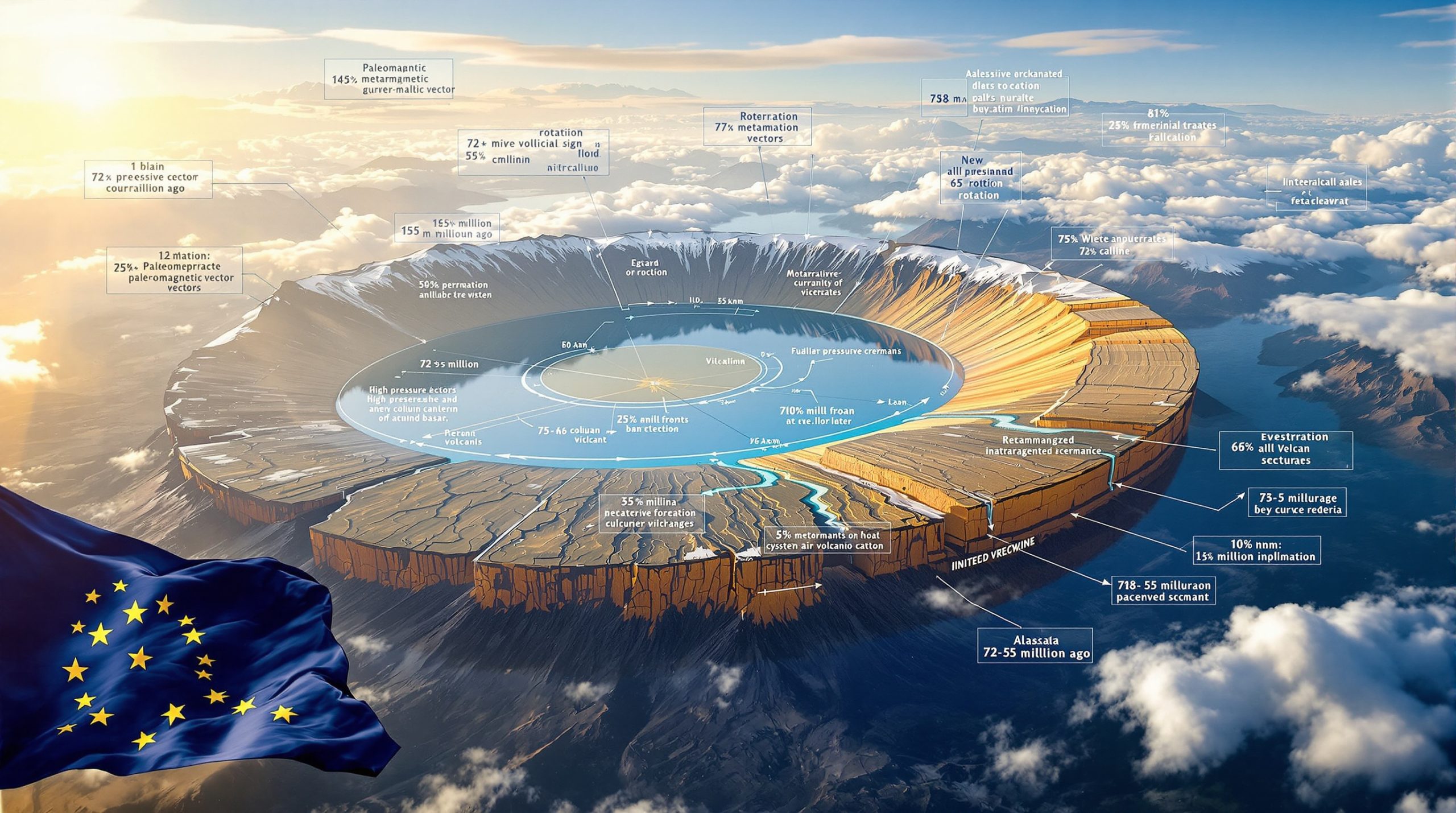Arctic Town Relocation: Mining Expansion Reshapes Kiruna's Landscape
Sweden's Arctic municipality of Kiruna is undergoing one of the world's most ambitious urban transformation projects, relocating approximately one-third of its population to accommodate the expansion of Europe's largest underground iron ore mine. This monumental effort highlights the complex relationship between resource extraction and community sustainability in remote northern regions.
The scale of this relocation is unprecedented – approximately 6,000 residents must move to new homes as the state-owned mining company LKAB expands its operations beneath the town. According to the latest forecasts released in August 2025, an additional 2,700 homes will require relocation within the coming decade, significantly more than initially projected.
The expanding footprint of LKAB's iron ore operations
LKAB's recent announcement about expanding operations has raised concerns about the growing impact on Kiruna's residential areas. The company's August 2025 forecast revealed that thousands more homes would need relocation, representing a critical economic interest for Sweden. The Kiruna mine produces high-grade iron ore essential for steel manufacturing across Europe, making it a strategic national asset.
The mining company has emphasized that relocation "must start now to secure operations until and beyond 2035," underscoring the economic imperative driving this massive undertaking. This expansion timeline puts immediate pressure on both municipal resources and community planning efforts. Recent iron ore market trends suggest continued demand will maintain pressure for expansion.
Timeline of Kiruna's gradual migration
The relocation process has been unfolding gradually over decades:
- 2004: Initial relocation plans announced
- 2022: New retail district opened 3 kilometers from the original town center
- August 2025: Historic wooden church successfully relocated to its new site
- 2025-2035: Projected timeframe for relocating 6,000 additional residents
This phased approach allows for careful planning but also creates extended periods of transition and uncertainty for residents.
What makes Kiruna's relocation project globally significant?
Kiruna's transformation represents an unprecedented engineering and social experiment that has captured international attention. Few communities worldwide have undertaken such comprehensive relocation efforts while attempting to preserve their cultural identity and social cohesion.
The project serves as a potential model for other communities facing similar pressures from resource extraction, climate change, or other environmental factors that may necessitate relocation. The scale, complexity, and long-term nature of Kiruna's move make it a case study in balancing economic interests with community preservation.
Engineering challenges of moving an entire town
The relocation involves not just building new structures but physically moving historic and culturally significant buildings. The town's wooden church, a beloved architectural landmark, was recently transported to its new location using specialized remote-controlled flatbed trailers, as reported by The Guardian.
This complex operation required:
- Detailed structural analysis to ensure the building's integrity during transport
- Custom-designed transportation systems to distribute the weight evenly
- Careful route planning to navigate the 3-kilometer journey
- Continuous monitoring for structural stress during the move
Each historic structure presents unique challenges, requiring innovative engineering solutions that preserve architectural heritage while ensuring structural integrity.
Balancing industrial needs with community preservation
The relocation highlights the delicate balance between resource extraction and community sustainability. While the mine expansion is economically necessary, it creates significant social and cultural challenges for residents.
Municipal leaders face the difficult task of maintaining community cohesion during this physical upheaval. The preservation of key landmarks, recreation of familiar spaces, and thoughtful urban design in the new town center are all critical elements in this balancing act. Furthermore, declining iron ore prices have added economic pressure to maximize extraction efficiency.
What role is the Swedish government playing in Kiruna's relocation?
The scale of Kiruna's relocation has prompted municipal leaders to seek direct intervention from Sweden's national government, highlighting the limitations of local resources in managing such an extensive project.
Municipal call for state intervention
In August 2025, Kiruna's municipal leader Mats Taaveniku made a public appeal for government assistance, stating: "We can't manage without help from the state and the government in this situation." This call for support reflects the extraordinary financial and logistical challenges facing the municipality as it attempts to relocate a third of its residents.
The municipal government has emphasized that the national significance of the mine's economic contribution should be matched by national support for the community bearing the burden of displacement.
Government response to Kiruna's appeal
Sweden's Minister for Energy, Business and Industry, Ebba Busch, acknowledged the municipality's challenges, noting the need to "prioritize between different national interests." The minister's statement recognized the complex balancing act between:
- Securing Sweden's domestic supply of critical raw materials
- Maintaining community stability and social welfare
- Reducing dependence on imports from "dangerous states"
- Preserving cultural heritage and community identity
The minister also confirmed that the government had contacted the municipality and understood the challenges it was facing, signaling potential for future collaboration and support.
How are costs and responsibilities being distributed?
The financial burden of relocating an entire town raises significant questions about responsibility and cost allocation between corporate, municipal, and national stakeholders.
Corporate responsibility in community relocation
LKAB, as the state-owned mining company driving the expansion, has committed to participating in compensation efforts. According to Minister Busch, LKAB "has been clear that it will take part in the compensation," though the exact parameters of this commitment remain under discussion.
The company's dual role as both an economic engine for the region and the cause of displacement creates complex dynamics in determining appropriate compensation. As a state-owned enterprise, LKAB must balance profitability with social responsibility in a way that private mining companies might not. Industry analysts point to 2025 iron ore forecasts as justification for the expansion despite relocation costs.
Economic implications for Kiruna's residents
For affected residents, the relocation raises numerous financial and practical concerns:
- Property valuation and compensation mechanisms
- Costs associated with relocation and establishing new homes
- Potential changes in property values in the new town center
- Disruption to businesses and local economic activities
- Access to services during the transition period
The uncertainty surrounding these issues has created anxiety within the community, with many residents concerned about their financial future and quality of life in the new town center.
What precedents does Kiruna set for other mining communities?
The Kiruna relocation represents a potential model for other communities facing similar pressures from resource extraction activities, particularly in Arctic and sub-Arctic regions where mining plays a significant economic role.
Global relevance for resource-dependent communities
Communities worldwide are watching Kiruna's experience as they face similar challenges:
- Mining towns in northern Canada and Alaska with expanding operations
- Communities in Australia's mining regions experiencing growth pressures
- Arctic settlements adapting to changing industrial and environmental conditions
The lessons learned in Kiruna could inform policy and planning in these other regions, potentially establishing new standards for how mining companies and governments manage community impacts. The need for mining reclamation innovations is particularly relevant as expansion continues.
Lessons emerging from Kiruna's experience
Several key lessons are already emerging from Kiruna's relocation process:
- The importance of early and comprehensive planning
- The need for clear communication with affected residents
- The value of preserving cultural landmarks and community spaces
- The challenges of maintaining social cohesion during physical relocation
- The complex interplay between national economic interests and local community needs
These insights may help other communities anticipate challenges and develop more effective approaches to similar situations.
How is Kiruna preserving its cultural identity during relocation?
Beyond the physical movement of buildings and people, Kiruna faces the challenge of maintaining its unique cultural identity and sense of community during this massive transition.
Preservation of architectural heritage
The careful relocation of Kiruna's wooden church symbolizes the broader effort to preserve the town's architectural and cultural heritage. The church, considered one of Sweden's most beautiful wooden structures, was moved intact rather than demolished and rebuilt—a technically challenging but culturally significant choice, as documented by Deutsche Welle.
This preservation effort recognizes that buildings are not merely physical structures but repositories of community memory and identity. By relocating rather than replacing key landmarks, planners hope to maintain a sense of continuity despite the physical disruption.
Creating continuity in the new town center
Urban planners have focused on creating visual and functional connections between the old and new town centers:
- Incorporating familiar architectural elements in new construction
- Recreating key public spaces and gathering points
- Establishing clear sightlines and transportation links between old and new areas
- Preserving place names and local references in the new development
These design strategies aim to help residents transition more easily to their new surroundings while maintaining the community's distinctive character and sense of place.
What environmental considerations factor into Kiruna's relocation?
The relocation project presents both environmental challenges and opportunities as the town rebuilds itself from the ground up.
Environmental impacts of the relocation process
The physical relocation generates significant environmental considerations:
- Construction waste and demolition materials from structures not being relocated
- Energy consumption associated with new construction
- Land use changes as the town footprint shifts
- Potential for implementing more sustainable infrastructure
Managing these impacts requires careful planning and mitigation strategies to minimize the environmental footprint of this massive undertaking.
Opportunities for environmental innovation
The necessity to rebuild provides opportunities to incorporate advanced environmental design:
- Energy-efficient building standards in all new construction
- District heating systems utilizing waste heat from mining operations
- Improved public transportation networks to reduce vehicle dependence
- Climate-adapted urban design appropriate for Arctic conditions
These innovations could position the new Kiruna as a model for sustainable Arctic development, potentially offsetting some of the environmental impacts of the mining operation itself.
What does Kiruna's future look like?
As Kiruna undergoes this transformation, questions emerge about the long-term sustainability of this mining-dependent community and its ability to maintain economic vitality while preserving its unique character.
Economic diversification beyond mining
While LKAB's mine remains the economic engine of Kiruna, the relocation process has prompted discussions about economic diversification:
- Development of tourism focused on the Arctic environment and the relocation itself
- Expansion of research facilities studying Arctic conditions and climate change
- Growth in services supporting the region's indigenous Sami communities
- Potential for new industries leveraging the region's natural resources
This diversification could help create a more resilient local economy less dependent on a single industry or company. However, surging iron ore demand suggests mining will remain central to the region's economy.
Community resilience in a changing Arctic
Kiruna's experience highlights broader questions about community sustainability in the Arctic region:
- Adapting to climate change impacts affecting northern communities
- Balancing resource extraction with environmental protection
- Maintaining population stability in remote northern regions
- Preserving indigenous knowledge and cultural practices
The lessons learned through Kiruna's relocation may inform how other Arctic communities address these challenges in the coming decades.
FAQs About Kiruna's Relocation
How much will Kiruna's relocation cost?
While exact figures continue to evolve, the total cost of relocating Kiruna is estimated to be in the billions of Swedish kronor, shared between LKAB, municipal authorities, and potentially the national government. The recent announcement that an additional 2,700 homes will need relocation significantly increases the projected costs.
How are residents compensated for their relocated homes?
LKAB has established a compensation model that offers residents either financial compensation based on market value plus a premium or the opportunity to move into equivalent housing in the new town center. This approach aims to ensure residents aren't financially disadvantaged by the forced relocation.
What happens to the old town center after residents move?
Areas of the old town center become gradually incorporated into the mining zone as ground subsidence makes them unsafe for habitation. Some areas are being transformed into parks or buffer zones before eventually becoming part of the mining operation's footprint.
How are businesses affected by the relocation?
Businesses face both challenges and opportunities during the relocation. While the disruption can affect established customer patterns, the new town center offers modern facilities and the potential to redesign commercial spaces for contemporary needs. LKAB and municipal authorities have developed support programs to assist businesses during the transition.
Further Exploration
Readers interested in learning more about urban relocations due to mining activities can also explore related educational content about the challenges and solutions for communities affected by resource extraction operations. The case of Kiruna represents a unique example of how arctic town relocation due to mine expansion can be managed through careful planning and cooperation between government, industry, and local communities.
Want to Identify the Next Major ASX Mining Discovery?
Discovery Alert's proprietary Discovery IQ model provides instant notifications when significant mineral discoveries are announced on the ASX, giving investors a crucial edge in the market. Explore how historic discoveries have generated substantial returns by visiting Discovery Alert's dedicated discoveries page and position yourself ahead of the market.




